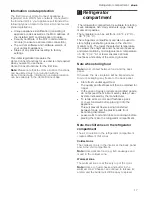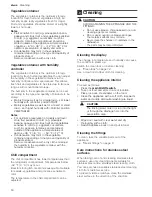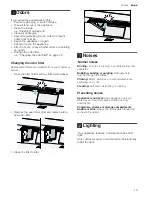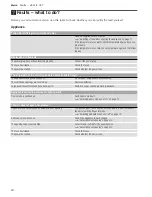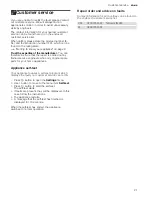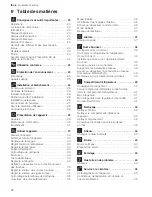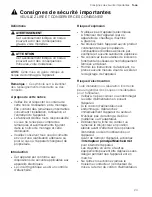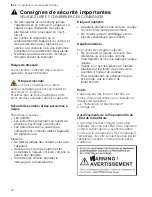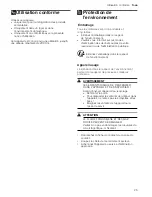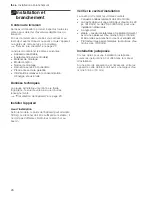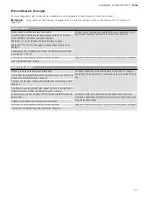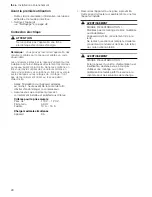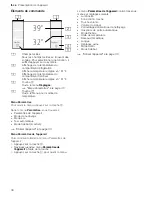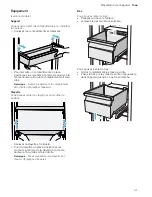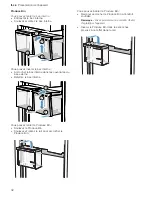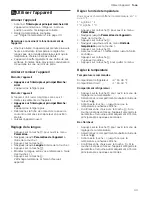
en-us
Cleaning
18
Vegetable container
The vegetable container is the optimum storage
location for fresh fruit and vegetables.A high air
humidity keeps leafy vegetables fresh for longer.
Fruit and vegetables should be stored at a slightly
lower air humidity.
Notes
■
Fruit sensitive to cold (e.g. pineapple, banana,
papaya and citrus fruit) and vegetables sensitive
to cold (e.g. eggplant, cucumbers, zucchini,
peppers, tomatoes and potatoes) should be
stored outside of the appliance at temperatures
of approx. +8 °C/+36 °F ... +12 °C/+46 °F for
optimum preservation of quality and aroma.
■
Condensation may form in the vegetable
container depending on the type and quantity of
products stored.
Remove condensation with a dry cloth.
Vegetable container with humidity
controller
The vegetable container is the optimum storage
location for fresh fruit and vegetables.You can adjust
the humidity in the vegetable container via the
humidity controller and a special seal. This allows
fresh fruit and vegetables to be stored up to twice as
long as with conventional storage.
The humidity in the vegetable container can be set
according to the type and quantity of products to be
stored:
■
Mainly fruit as well as for a large load – set lower
humidity with controller position FRUIT
■
Mainly vegetables as well as for a mixed or small
load – set higher humidity with controller position
VEGETABLES
Notes
■
For optimum preservation of quality and flavor
store fruit sensitive to cold (e.g. pineapple,
banana, papaya and citrus fruit) and vegetables
sensitive to cold (e.g. eggplant, cucumbers,
zucchini, peppers, tomatoes and potatoes)
outside of the appliance at temperatures of
approx. +46 °F (+8 °C) ... +54 °F (+12 °C).
■
Condensation may form in the vegetable
container depending on the type and quantity of
products stored.
Remove condensation with a dry cloth and adjust
the humidity in the vegetable container with the
humidity controller.
Chill compartment
The chill compartment has lower temperatures than
the refrigerator compartment. Temperatures below
+32 °F (0 °C) may occur.
Ideal for storing fish, meat and sausage. Not suitable
for salads, vegetables and groceries sensitive to
cold.
The temperature in the chill compartment can be
adjusted.
D
Cleaning
Cleaning
9
CAUTION
AVOID DAMAGING THE APPLIANCE AND THE
FITTINGS.
■
Do not use abrasive, chloride-based or acidic
cleaning agents or solvents.
■
Do not use scouring or abrasive sponges.
The metallic surfaces may corrode.
■
Never clean the shelves or containers in the
dishwasher.
The parts may become deformed.
Cleaning the display
The change in temperature and humidity can cause
the controls to steam up.
Switch the clean lock on before cleaning.
Use a clean micro-fiber cloth for cleaning.
Cleaning the appliance interior
Proceed as follows:
1.
Press the
main On/Off switch
.
2.
Take out food and store in a cool location.
Place ice pack (if available) on the food.
3.
Clean the appliance with a soft cloth, lukewarm
water and a little pH-neutral washing-up liquid.
9
CAUTION
The rinsing water must not run into the light
or through the drainage hole into the
evaporation area.
4.
Wipe door seal with clear water and dry
thoroughly with a cloth.
5.
Switch appliance back on and put in food.
Cleaning the fittings
To clean, take the variable parts out of the
appliance.
Care instructions for stainless steel
surfaces
When taking care of and cleaning stainless steel
surfaces, use only cleaning agents suitable for
stainless steel and a stainless steel cleaning cloth.
You can purchase a suitable stainless steel cleaning
cloth from customer service.
To prevent visible scratches, clean the stainless
steel surface in the direction of the structure.














